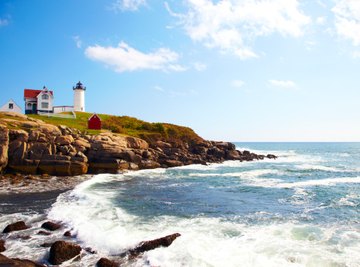
Water currents can be found in streams, rivers and oceans throughout the world. Water current is the rate of movement in the water, and ways to describe water current include its speed and direction. There are different types of water currents which behave in different ways because they are affected by separate variables.
River and Stream Currents
River and stream currents are created by the water flowing from the source of the river or stream, to the ocean where the water is dispersed. Gravity plays its part in river and stream currents because the source is found above sea level so the water must flow downhill. The speed and strength of the current varies throughout the course of the river or stream because of variables like the steepness of the land and obstacles in its path.
Rip Currents
Rip currents, sometimes referred to as rip tides, are most commonly found at beaches that have waves breaking on the shoreline, but can also occur at lakes where waves are breaking. A rip current is the movement of water away from the shoreline and out to sea. When waves break on a beach water is pushed onto the land, and as the water flows back into the ocean it finds a way between the breaking waves, and this water movement is a rip current.
Ocean Currents
The main causes of ocean currents are wind, the Earth’s rotation and differences in water density within oceans. Different types include surface currents, deep ocean currents and tidal currents. The majority of the world's oceans' surface currents are caused by the wind. The most common deep ocean currents are the result of water density. The more salty and cold ocean water is the denser is it. More dense water drops to the bottom of the ocean and separates from less dense water, and that movement creates a current. The Earth’s rotation and its effect on gravity cause different tidal currents to occur on a regular basis.
Uses for Water Currents
As more information is found out by people studying water currents, more uses are being found for them. Knowledge of ocean currents has been helping and hindering sailors’ efforts to sail across the world’s oceans for centuries. Strong river currents have been utilized to provide clean energy through the use of hydroelectric plants. Technology has also been developed to capture the energy produced by the rise and fall of the oceans' tides.
References
About the Author
Based in the U.K., Jack Taylor has been writing environmental, sports and travel-related articles since 2006. His writing has been featured in publications such as "Drift" magazine, the "Journalist" magazine and the "Newquay Voice" newspaper. He holds a Bachelor of Arts in journalism from University College, Falmouth.
Photo Credits
Thomas Northcut/Photodisc/Getty Images
